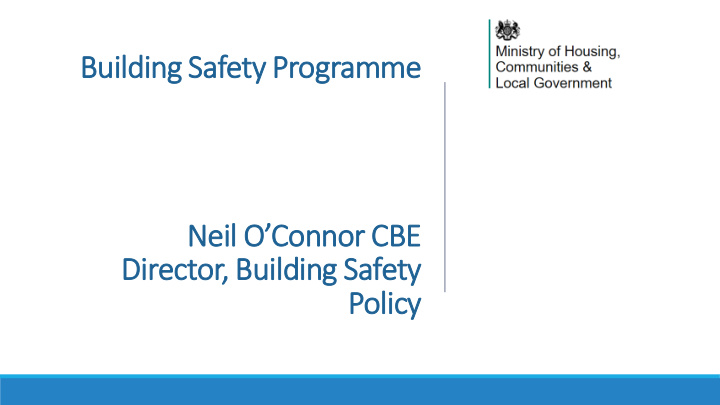



Building Safety Programme Neil O’Connor CBE Director, Building Safety Policy
Grenfell tragedy Deadliest fire in Britain since the start of the 20 th century. 72 lives lost and 151 homes. Within days, became clear that key factors believed to have contributed to the spread of fire may be widespread. Building safety programme established. Ensure residents are safe and feel safe now and in the future. Remediate ACM cladding and reform the regulatory system.
Established immediately after the Grenfell Tower fire; chaired by Sir Martin Moore-Bick (former Court of Appeal judge). • Phase 1 (covering events on the night of the fire) – hearings from June-December 2018; report and recommendations expected in October. • Phase 2 (wider systemic issues) – Hearings are expected to begin early next year. Building Safety Programme is monitoring and will respond to recommendations.
Social Housing Green Paper: Published on 14 August 2018. Sets out five principles that underpin a new, fairer deal for social housing residents: A new deal for • A safe and decent home is of central importance and government is social housing committed to meaningful change; • Swift and effective resolution of disputes, including how to resolve complaints more easily and be more transparent; • Empowering residents and ensuring their voices are heard so that landlords are held to account; • Tackling stigma and celebrating thriving communities, challenging the stereotypes that exist about residents and their communities; • Boosting the supply of social housing and supporting home ownership. Action Plan to be published in response.
Remediation – progress to date 433 high-rise buildings with unsafe Aluminium Composite Material (ACM) cladding have been identified (31 May, 2019). • All have interim safety measures in place; • 105 remediated; • 107 have work underway; • 176 have plans in place or in development. • £600m available to social and private sector landlords to fund removal and replacement of dangerous ACM cladding. • £259m allocated across 140 buildings to date. Additional support for local authority enforcement
Other safety issues being addressed • Potential structural issues with Large Panel System buildings. • Potential degradation and fire performance issues with other types of cladding and wall materials. • Failures in composite fire doors to meet 30 minute fire test standards.
Building a Safer Future: Independent Review Independent Review of Building Regulations and Fire Safety – the ‘Hackitt’ review. Commissioned July 2017. Final report published May 2018. Review says regulatory system for high-rise and complex buildings was not fit for purpose. Identifies key issues underpinning system failure as: ignorance, indifference, lack of clarity on roles and responsibilities, inadequate regulatory oversight and enforcement tools. A “race to the bottom”.
Building a Safer Future: An Implementation Plan Government response and Implementation Plan published on 18 December 2018. Committed to delivering meaningful and lasting change, giving residents a stronger voice and putting clear responsibility and accountability at the heart of a more effective system. Taking forward all of the Independent Review recommendations. Bringing forward legislation, taking action in the meantime to make changes on the ground. More detailed consultation promised for spring 2019.
Building a Safer Future: Consultation More detailed consultation to inform legislation published on 6 June. Five broad areas of reform: ◦ The scope of the new regime; ◦ The concept of dutyholders who have clear responsibilities throughout a building’s design, construction and occupation; ◦ Giving residents a stronger voice in the system and ensuring their concerns are never ignored ◦ Plans for a new building safety regulator to provide oversight of the new regulatory regime ◦ Strengthened enforcement and sanctions to deter non- compliance with the new regime.
In addition to remediation work and implementing all of the Independent Review recommendations, Government has acted on a number of other fronts: ◦ Call for evidence on the Regulatory Reform (Fire Safety Order) 2005 Bui Buildin ing Sa Safety ty – ◦ Review of the Housing Health and Safety Rating System ◦ Clarification of Approved Document B (the Building Regulations Goin Go ing Fu Furth ther guidance on fire safety) ◦ Banned combustible cladding in high rise buildings; ◦ Restricted assessments in lieu of tests (desktop studies); ◦ Full technical review of Approved Document B; ◦ How residents are supported to keep buildings safe; ◦ Joint Regulators Group; ◦ Early Adopters; ◦ Residents’ Reference Panel; ◦ Industry Safety Steering Group.
Final points “There is no reason to wait for legal change to start the process of behaviour change once it is clear what is coming and what is expected. A sense of urgency and commitment from everyone is needed.” Dame Judith Hackitt “We must create a culture that truly puts people and their safety first, that inspires confidence and, yes, rebuilds public trust.” The Rt Hon James Brokenshire MP All of our information and advice is on the web at https://www.gov.uk/guidance/building- safety-programme
Recommend
More recommend